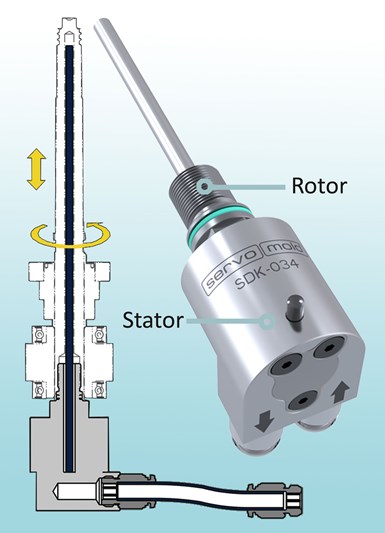Tooling: Rotary Cooling Device for Demolding Rotating Cores
Compact rotary cooling units provide a cost-efficient means to integrate rotating cores into molds, while providing greater cooling for faster cycles.
i-mold (Erbach, Germany) says the compact standardized unit consists of twist-lock installed stator with coolant hose connectors and a rotor, which supports the cooling pipe and the thread to attach the rotating core. i-mold says this technology reduces the time and cost associated with a custom rotating core, as well as eliminating potential cooling water leaks since each unit is leak-tested and warrantied leakproof by i-mold.

i-mold compact rotary cooling device standardizes a technology that is usually a custom product.
In multicavity molds, i-mold says processors can connect up to four rotary cooling units in series. Additional groups of four can then be arranged in parallel, creating compact molds with a large number of rotating cores.
The rotary cooling units are suitable for all common mechanical, hydraulic or servoelectric rotating core drives. The unit is offered in two sizes: SDK-034, rated for a 2- to 6-mm cooling pipe diameter with cavity spacing of 34 mm, and the 45-mm-wide SDK-045 for higher coolant flow rates with cooling pipes measuring from 6 to 10 mm in diameter. The default cooling pipe length is 300 mm with customized lengths available. The core attachment thread may be supplied in either metric fine or inch-type.
Standard plug-in couplings connect the coolant hoses, with optional quick-acting couplings available. The minimum bending radius of the coolant hoses depends on the material required for the given temperature range. It is equal to 35 mm for coolant temperatures up to 60C; 50 mm for up to 80C; and 90 mm for hoses rated up to 120C. The maximum operating pressure is 10 bar (145 psi). Filtered water can be used as the coolant with a filter fineness of 0.05 mm or below.
Related Content
-
Three Key Decisions for an Optimal Ejection System
When determining the best ejection option for a tool, molders must consider the ejector’s surface area, location and style.
-
How to Start a Hot-Runner Mold That Has No Tip Insulators
Here's a method to assist with efficient dark-to-light color changes on hot-runner systems that are hot-tipped.
-
How to Design Three-Plate Molds: Part 5
There are many things to consider, and paying attention to the details can help avoid machine downtime and higher maintenance costs. In this installment, the focus is on design and placement of sucker/puller pins.








